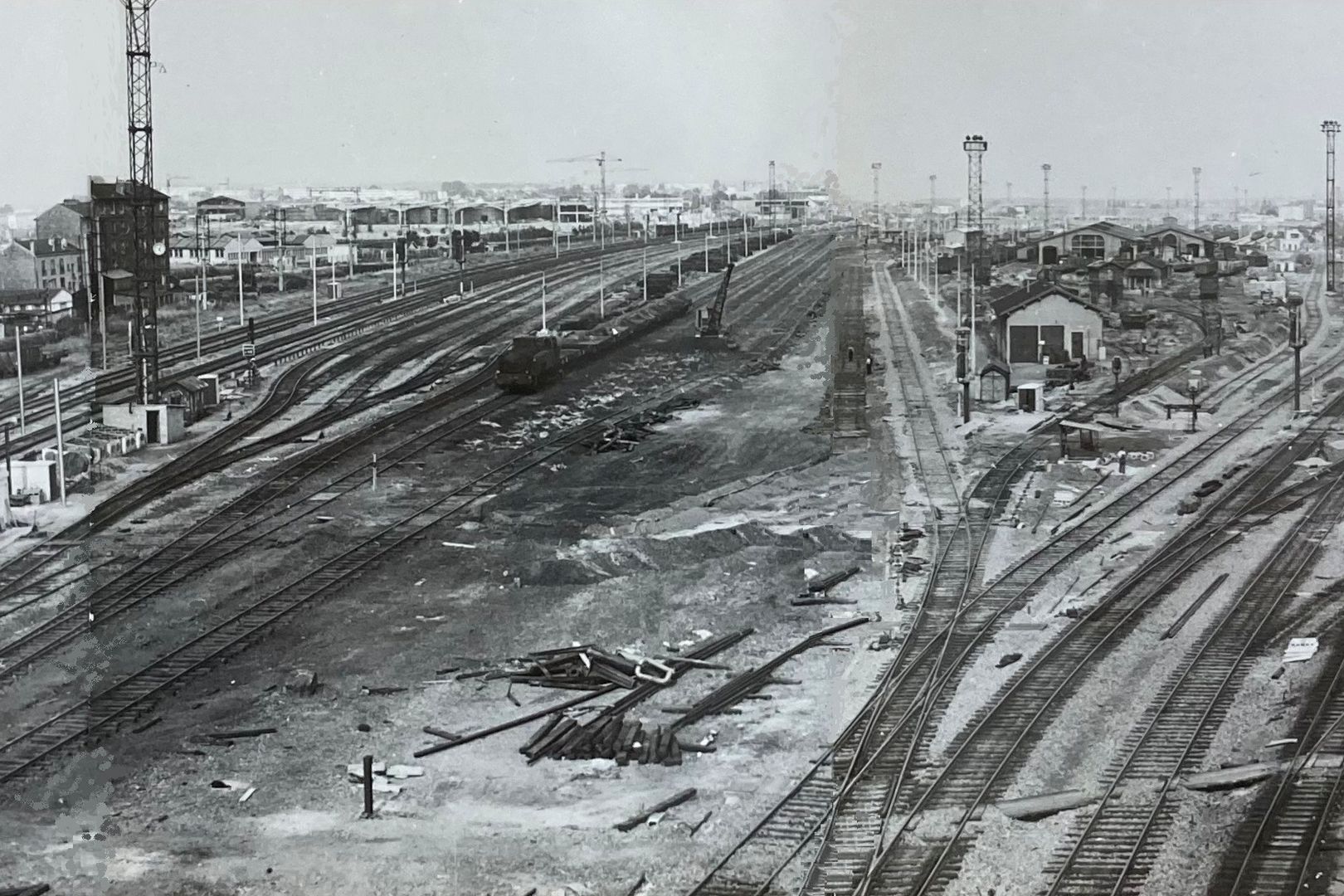
Le triage dans les années 50

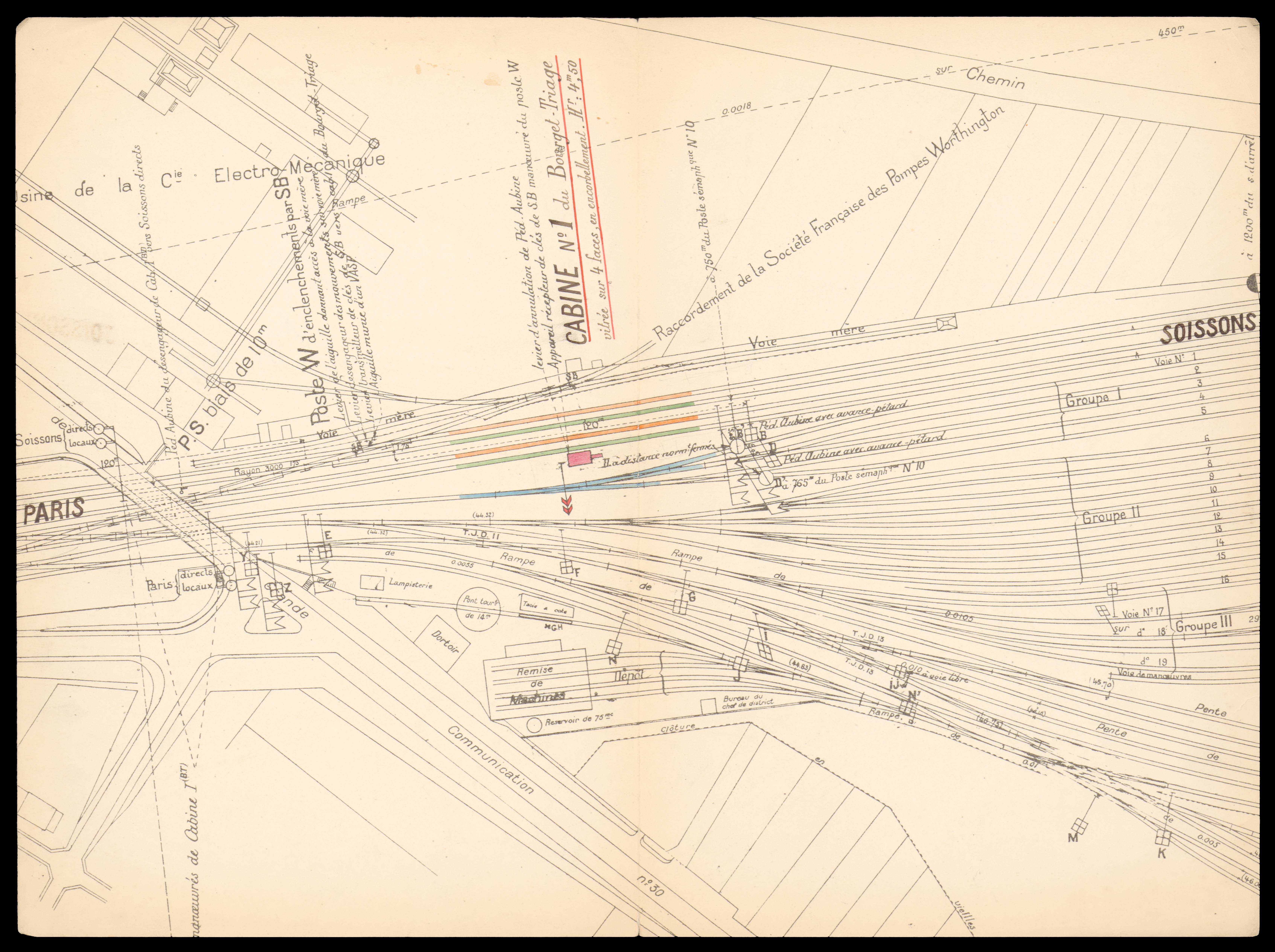
SARDO CNAH - 0003LM2996
The railroad at Drancy is closely linked to the development of the French network in the mid-19th century, and in particular to the project to create a new 210-kilometer line from Paris (La Plaine) to Hirson and Anor (Belgian border).
An agreement signed on June 21, 1857 between the Minister of Public Works and the Compagnie des chemins de fer du Nord awarded the concession for the line, which comprises two sections: the section from Paris (La Plaine) to Soissons, and a possible line from Soissons to the Belgian border, via Laon, Vervins and Hirson.
This first line from Paris to Soisson will be opened in stages:
4 juin 1860
Commissioning of the section from Paris-Nord station to Sevran station
31 août 1861
Commissioning of the Sevran to Villers-Cotterêts section
2 février 1862
Opening of the line to Soissons
Located on the first section of the line between Paris-Nord station and Sevran, Le Bourget-Drancy station was completed in 1863. During the 1870 war, it was completely destroyed by the Prussians and rebuilt the following year, 1871.
In the second half of the 19th century, Paris was booming, industries were expanding rapidly and the need for rapid transport of goods and raw materials was becoming vital. As a result, available space in the nearby countryside was coveted, and the proximity of the “young Soissons line” contributed to the development of new businesses and goods sorting activities in the Drancy and Le Bourget areas from 1863 onwards.
A marshalling yard was then gradually built, creating a large number of new jobs linked to the railroads and permanently changing the face of the small rural village.

Le Bourget - La gare. Fonds SARDO CNAH
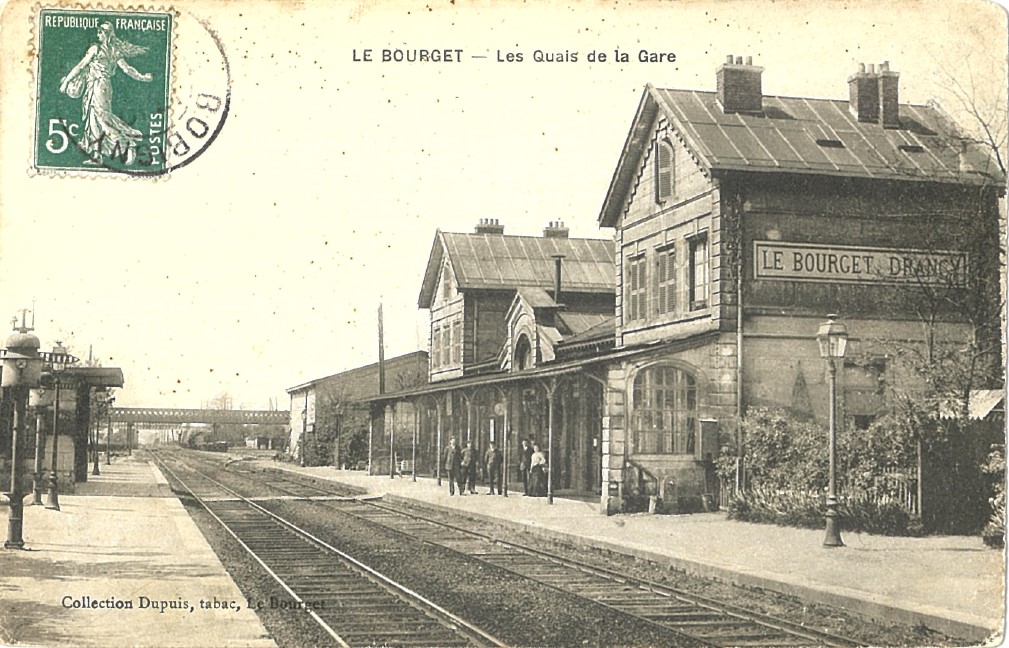
Le Bourget-Drancy, les quais de la gare. Fonds SARDO CNAH
A law of August 4, 1875 declared the establishment of a railroad known as the Grande Ceinture de Paris to be in the public interest.
On the following September 23, an agreement was signed between the Compagnies des chemins de fer du Nord, de l’Est, d’Orléans, and de Paris à Lyon et à la Méditerranée, creating the syndicat du chemin de fer de la Grande Ceinture de Paris. The new railway will partly use sections of lines already operated by these companies. The Grande Ceinture’s function was to double and unload Paris’s Petite Ceinture, while facilitating exchanges with the various national networks.
Not far from the Drancy station, a new Grande Ceinture du Bourget station was built in 1882 as part of the construction of the section linking Noisy-le-Sec to Le Bourget. It is located south of Le Bourget and north of Drancy, at the “Sablière au Blond” site in the Drancy area. The station is designed to serve Drancy, Le Bourget and Aubervilliers, and is dedicated to passenger and freight services. The station has now been demolished.
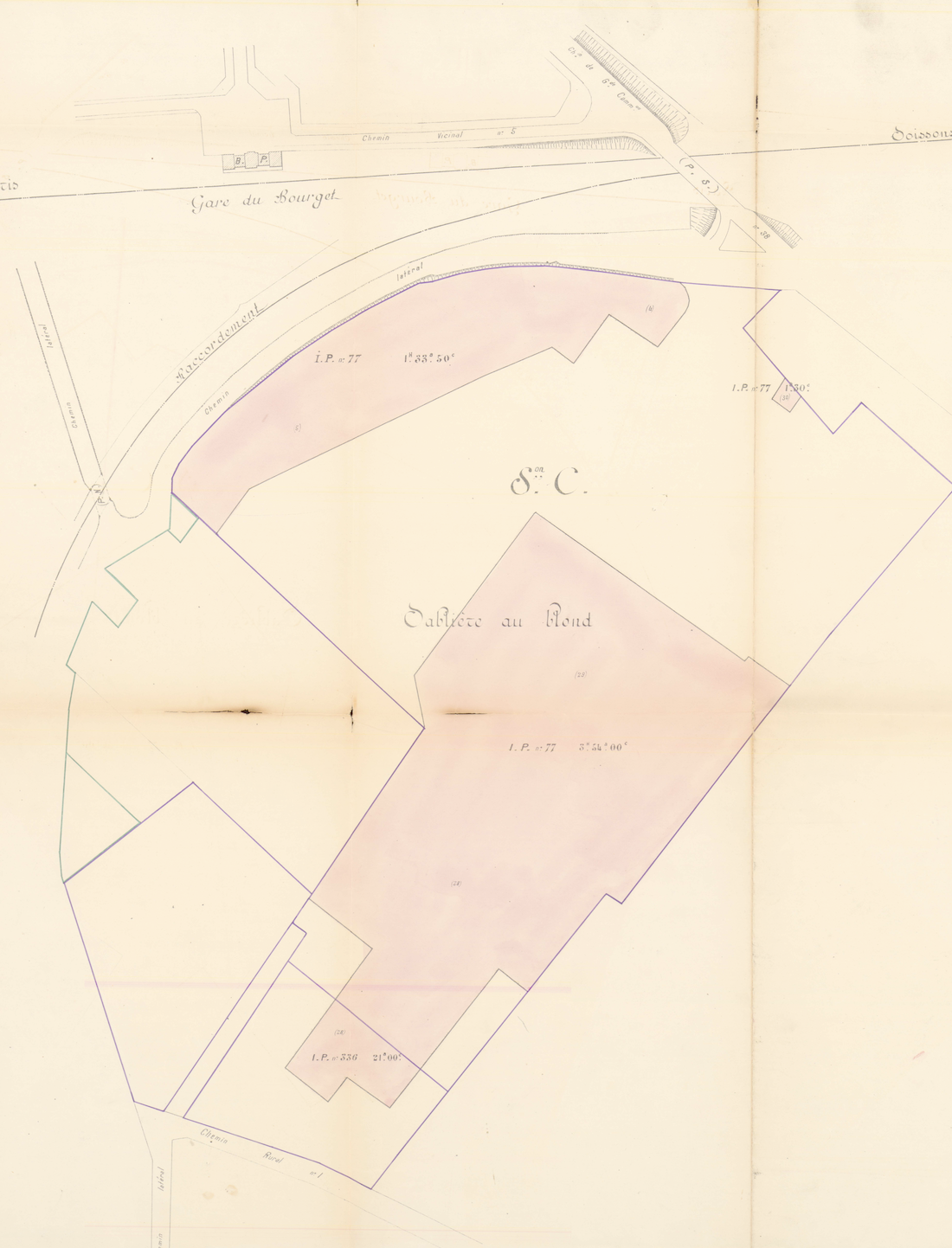
Plan de 1925. SARDO CNAH 0050LM0128
1904
The Syndicat du chemin de fer de la Grande Ceinture buys its first machines and takes over train traction from the Compagnies de l’Est and de l’Etat.
1910
The Syndicat takes delivery of 232T and 031+130T. At the same time, he also rents out 030s to the Companies, coupled as DT tenders against tenders in order to avoid overturning and forward tender movements, which are very restrictive.
1912
The Syndicat buys the land to build a depot for 30 type 031+130T machines. Construction was delayed by the war, and by 1918 the Bobigny depot was operational.
1920
This is where all the machines serving Argenteuil to Juvisy are grouped, i.e. 38 machines plus 34 others and 2 Mallets 1.3+3 (there is a 2nd proprietary depot in St Cyr).
1928
Complementary beltway and Noisy bypass open for service
1930
Opening of the Gagny connection and disappearance of the Voyageur service
1931
12 new 151T machines ordered for Bobigny
1935
Dissolution of the Syndicat du chemin de fer de la Grande Ceinture on January 1, 1935. Operations were taken over by the various existing companies. The Bobigny depot was then attached to the Bourget-Drancy depot.
The development of traffic and relations generates a great need for locomotives and therefore for marshalling and maintenance facilities.
In the summer of 1883, the Le Bourget-Drancy marshalling yard had :
But the marshalling yard soon proved too small, and in 1912, the Bourget interchange tracks were lengthened and a turntable installed on the Noisy side.
Between 1927 and 1930, a number of changes were made, including an extension of the marshalling yard towards Le Blanc-Mesnil, the creation of 4 new tracks at Le Bourget échange, and the elimination of the turntable to extend the tracks.
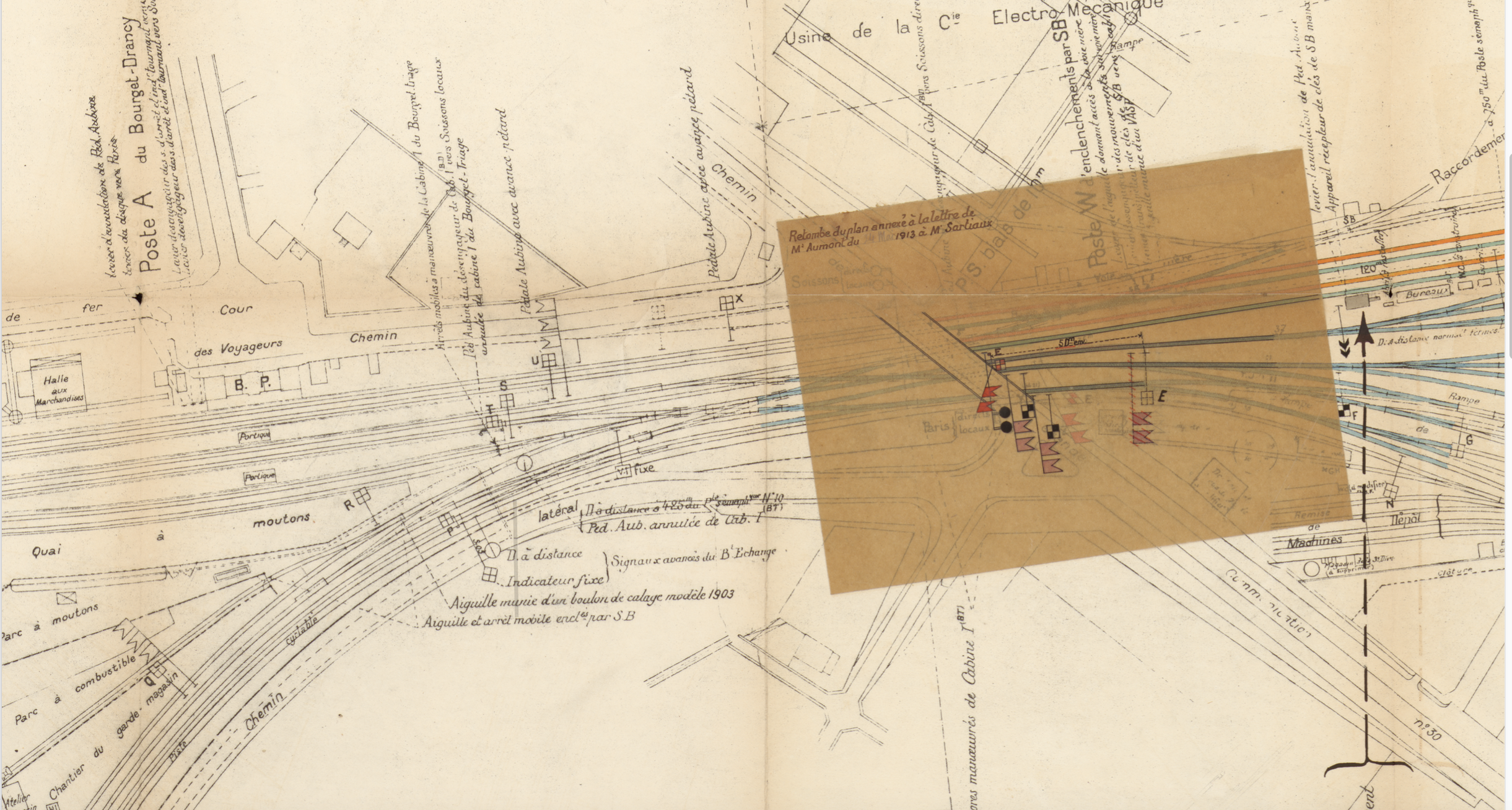
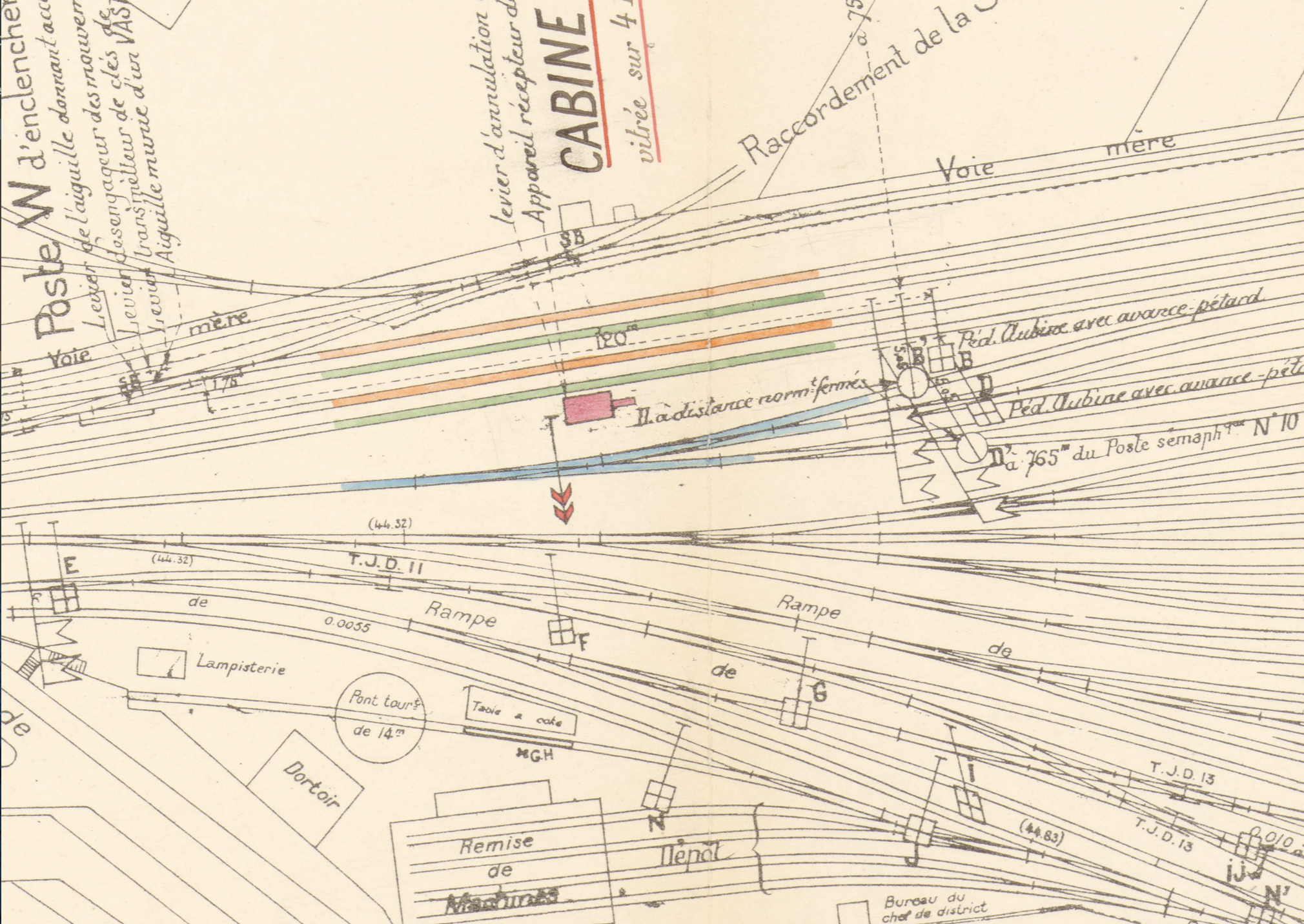
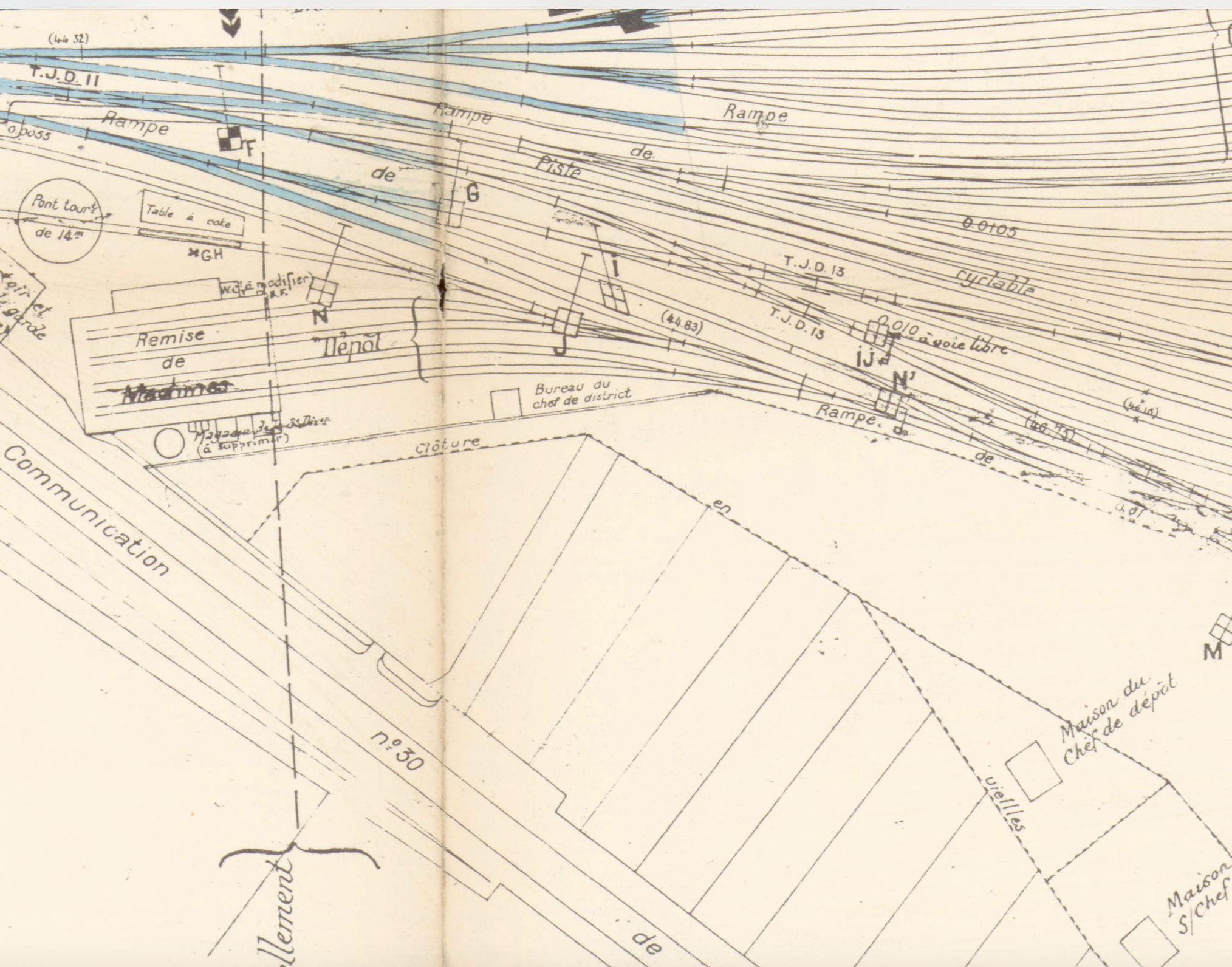
3 plans de 1913. SARDO CNAH 0003LM2996
In 1947, plans were made to build a rotunda on the south side (in red on the plan). Now demolished, it stood directly opposite the current Drancy multimedia library.
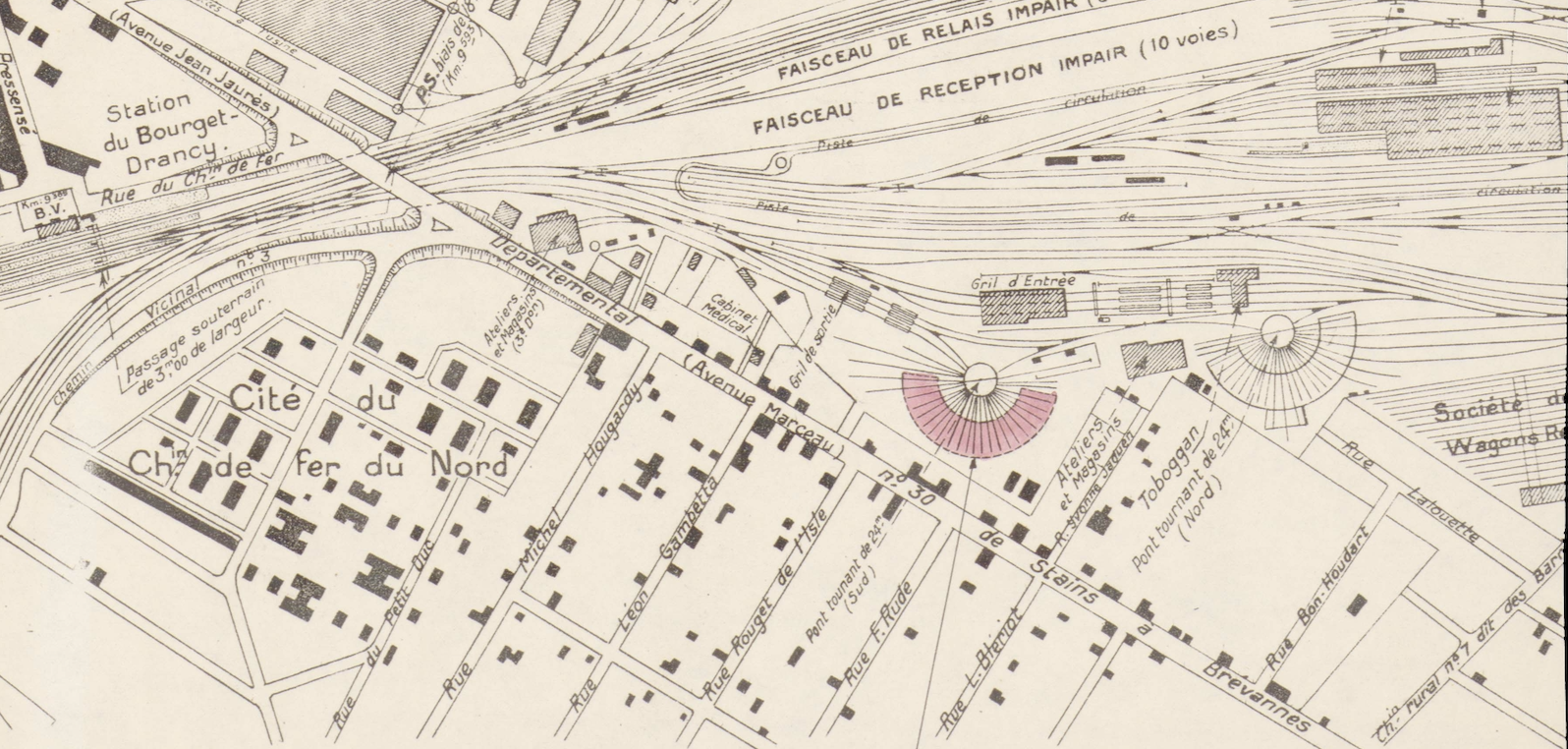
Plan de 1947. SARDO CNAH 0505LM0044
An SNCF roundhouse is a railway facility used mainly for locomotive maintenance and turning. Here are some of its main functions:
Today, with the increasing use of electric and diesel locomotives, the need for turnarounds is less frequent, but maintenance and storage facilities remain relevant.
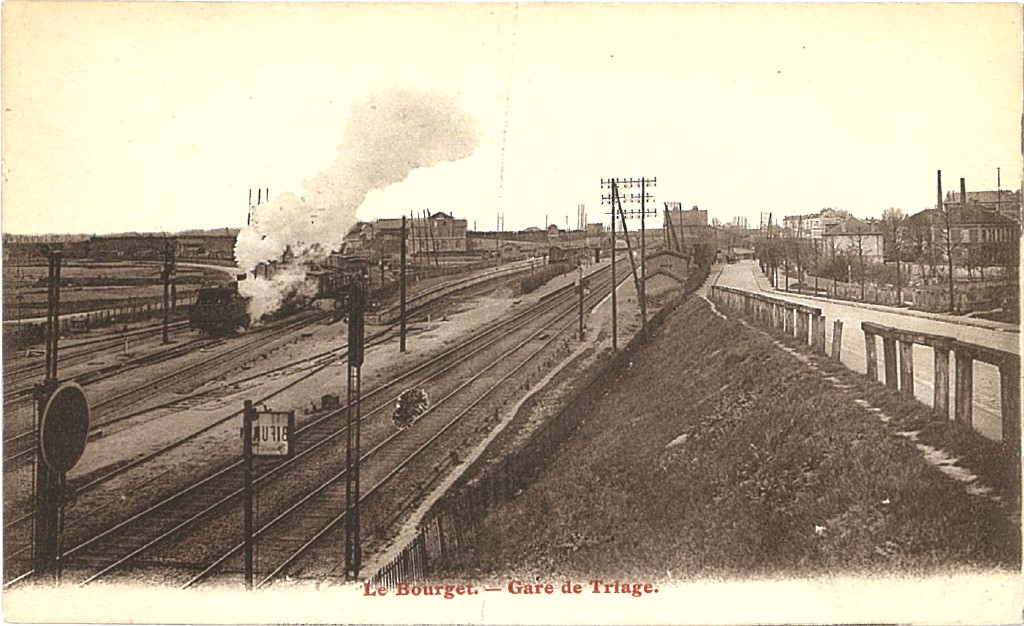
Le Bourget, gare de triage. Fonds SARDO CNAH
In 1886, a Compagnie du Nord depot was already established in Le Bourget. It’s essentially a goods warehouse with machines whose types will evolve over time. They are assigned to the many coal trains coming from the north. Paris needs it for heating, lighting and coal production.
The “fuel park” of the 1er MT district, an enormous reserve that supplied the various depots with coal and briquettes (coal dust compressed at high temperature, delivered in brick form): Le Bourget-Drancy and Bobigny, Mitry, Crépy, La Plaine, Paris Évangile, La Chapelle, Joncherolles, Persan-Beaumont, Creil or Compiègne.
In 1950, the Drancy-Le Bourget depot had 89 locomotives.
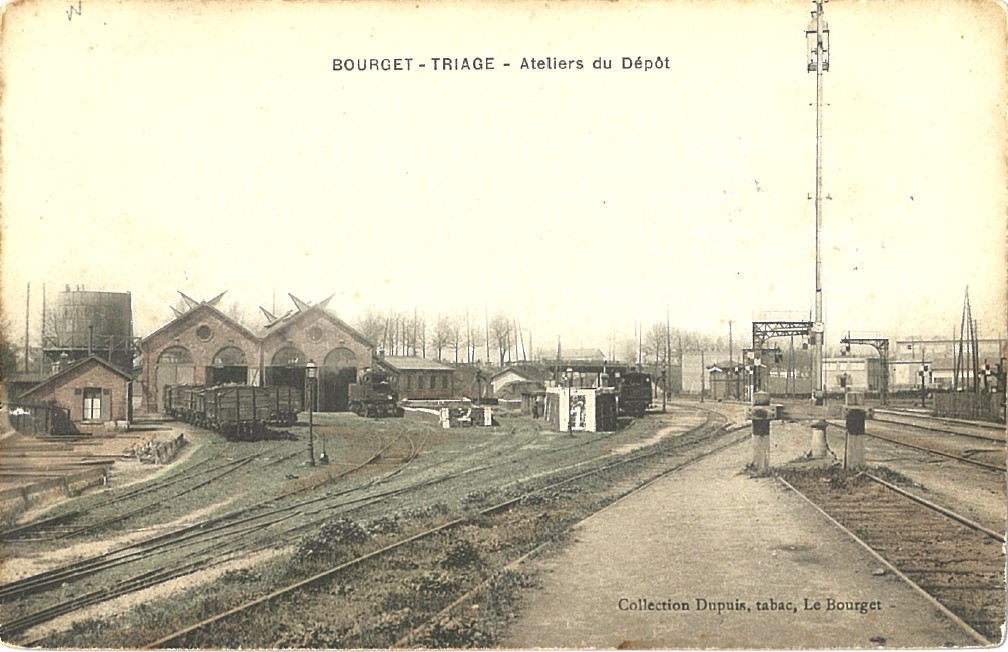
Bourget - Triage - Ateliers du Dépôt. Fonds SARDO CNAH
At the Liberation, to compensate for war losses, the SNCF received the famous 141 R steam locomotives, as well as a series of 040 DA diesel locomotives, which later became A1A A1A 62000. These diesel locomotives were built by Baldwin Locomotive Works in collaboration with Westinghouse Electric Corporation in 1946-1947. Following the same principle as the 141 R, they were the adaptation to European standards of a diesel locomotive already existing on American railroads, the Baldwin VO-1000 built from 1939 to 1946.
In the 1950s and 1960s, oil became more and more prevalent, gaining the upper hand over coal. Traffic is down sharply. In 1956, the 151 T steamers were transferred to the Drancy-Le Bourget and Nord depots in preparation for the diesselization of the Bobigny depot, which was attached to Le Bourget. In addition, SNCF orders 35 diesel locomotives, which will leave the factory between 1955 and 1959, to complement the American equipment.

SARDO CNAH, photographie du New York Times (1945) 0068LM0017
At the end of the Second World War, the shortage of locomotives and the inability of the rebuilding French industry to deliver large numbers of new machines quickly led to orders being placed with American and Canadian manufacturers.
Baldwin Locomotive Works drew up the plans for these machines, modifying for the French network a locomotive that had already been running for several years in the USA: the Mikado USRA light model. This technological choice, which shook up the French railway industrial conservatism of the time, was to prove judicious.
In February 1944, an order was placed for 700 locomotives, for all services, to make up the first tranche: 141 R 1 to 700. Once financing had been secured, a second tranche – the 141 R 701 to 1340 – was ordered from the same firms, backed up by Canadian builders. At the time, most of these machines were designed to run on fuel oil, rather than coal like their predecessors. The 604 oil-fired machines provided better service and were therefore more in demand than the coal-fired ones. Fuel oil saved coal, although in many depots it was a real revolution. They were financed under the 1941 Prêt-Bail law.
See the article on the reception of the first 141 R locomotive in Marseille in 1945.
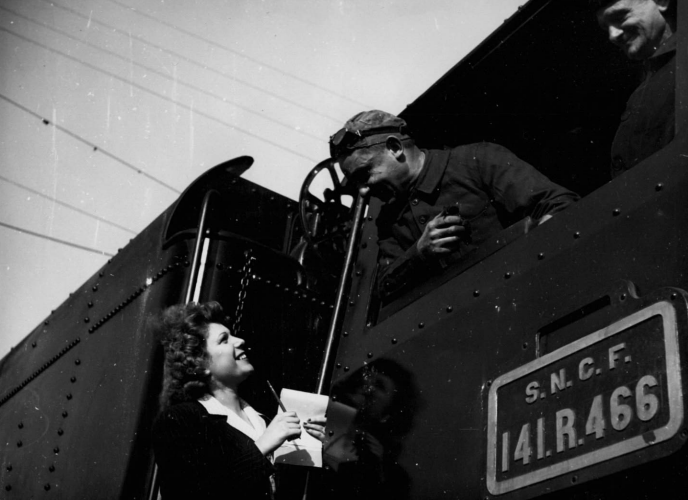
The electrification of the network, which began in the early 20th century, was a response to a variety of objectives: improving operating flexibility by reducing maintenance, enabling the use of powerful equipment, taking advantage of electricity production from dams, and reducing pollution and noise generated by trains.
From the 1960s onwards, 25 Kv was used on more and more lines in the Northern Region:
1957 à 1959
Paris/Lille /Somain/Lens and also Pierrefitte/Noisy to be commissioned
1962
Commissioning of Paris-Est/Vaires
1963
The BM, Paris / Ormoy / Verberie and Creil / Aulnoye la Belgique, are supplied with 25,000v.
Steam traction was phased out at the Le Bourget depot around 1957, and staff were distributed between Mitry, Bobigny, La Plaine and La Chapelle. A scrap dealer took possession of the premises and part of the covered rotunda was destroyed, along with the rest of the warehouse. All this is replaced by storage halls. The Le Bourget marshalling yard was also overhauled.
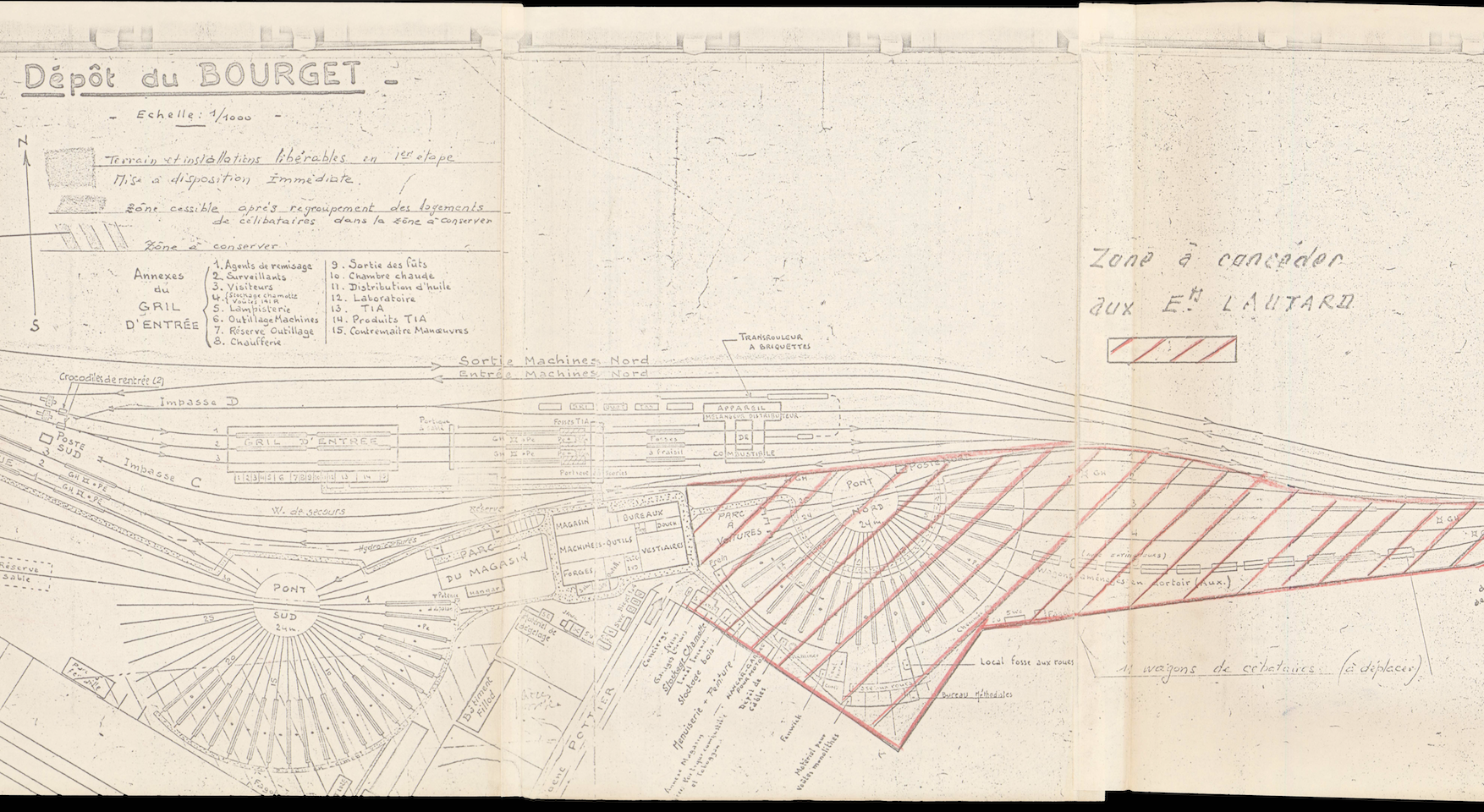
Plan de 1960. SARDO CNAH 0886LM0146

Le triage dans les années 50

Drancy-Le Bourget dans les années 60

Le dépôt dans les années 50

The SARDO was asked by Drancy’s media library to tell us about the history of the marshalling yard, so much a part of Drancy’s landscape, but ultimately so little known.
The exhibition entitled “The marshalling yard, a station like no other”. retraces the story of the arrival of the railroad in Drancy in the 19th century, using historical archive documents, photographs and objects selected from our collections.ème century and the gradual development of major railway facilities that have left their mark on the city’s landscape.
Guided tours of the exhibition were organized for the 2023 European Heritage Days, and a guided tour by the Director of SARDO was organized on September 20, 2023.
